Discover 3 films by Peter Kubelka, Adebar (1956-58), Schwechater (1956-57) and Arnulf Rainer (1958-60) as well as a selection of Austrian experimental films. A program curated by The Film Gallery with Six-Pack film.
Valie Export - Body politics - 1974 - 2:16 min
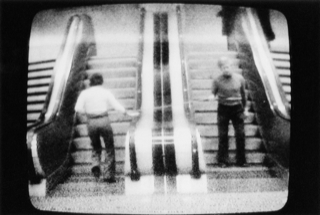
“The nature of communication between the sexes is predetermined in our society. The politics of behavior that our society imposes upon men and woman can be demonstrated in physical form. The escalator, consisting of stairs moving downward, demonstrates the existing communication systems in five separate phases. A man and a woman are connected by a rope tied around their bodies.”
(VALIE EXPORT)
Kurt Kren – 8/64 ANA – Aktion Brus – 1964 – 2min40
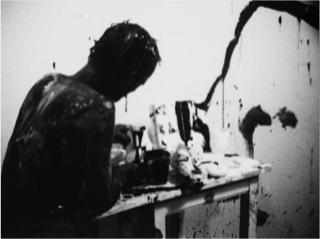
“With Ana - Aktion Brus, I saw that this was a good way of recording the whole action in single-frames. With the single frame shots, there was, of course, no cutting plan. Everything was done purely intuitively. There was not much to consider, and it all had to be done really quickly.”
(Kurt Kren)
“Kren’s first film of an «action» by Günter Brus. This three-minute film was far more akin to the American-style «happening» in that the content was not particularly extreme. It was built up from items such as broken bicycle parts, a nude model, pieces of furniture and these elements were then obscured or transformed by having a layer of paint thrown on them. Kren films short sequences from many different angles, using high-contrast black and white film to create an effect not unlike that of a painting by Robert Kline.”
(Stephen Dwoskin)
“Then comes Kren’s first film with Günter Brus – 8/64 Ana – Aktion Brus. The expressive style Kren is suddenly confronted with makes him depart from seriality and flash editing. His response is the “Great Abstraction”. Free gestural photography corresponds to Brus’s pathos; Kren pumps images of Tachist disintegration onto the filmstrip. While flash editing had made Mühl’s actions rage, the repetitive qualities had ensured that the “moving ornament” was still legible. The single-frame process Kren uses to record Brus’s action as if writing with his camera makes the image almost less than discernible.”
(Peter Tscherkassky)
Peter Tscherkassky - Ballett 16 – 1984 – 4min
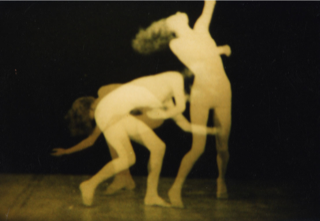
“My interest in the individual frame as constituting the core of filmic creation found early expression in several works based on static images or photographic frame enlargements, including Liebesfilm (1982), Sechs über Eins (1982) and Motion Picture (1984).
In the case of Ballett 16, 256 frame enlargements of a continuous dance movement were dissected into 16 segments, each consisting of 16 frames. These segments were rearranged and re-photographed frame-by-frame. The resulting synthetic composition of movement was re-photographed off a screen running at twice its normal speed in order to accelerate the final film. “
(Peter Tscherkassky)
Moucle Blackout - Die Geburt der Venus (Birth of Venus) – 1970-72 – 5 min.
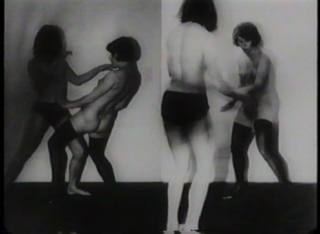
“The basic material consisted of about 30 photos showing some close friends, and a dead pig we had found on a road. The pictures of the pig are used as a symmetric motion-montage. I took proper and left/right-inverted photos which are moved back and forth symmetrically over the central axis.
The introduction-scene shows Botticelli´s «Birth of Venus,» cross-fading the figures at both sides and following the title, also Venus with a symmetrical pig-montage. A detail of B.´s picture appears at the end of the film on a wrapper of a lavoratory-deodorant (snif). Three Beatles songs emphazise the performance with their text. The pig is used as a symbol for the woman as a victim. It also stands for any associations to pig as proverbial: poor swine, filthy pig, greedy pig or it may allude to a pigsty or a pig in a poke, etc. The friends appear as: two dancing women, two lovers, a cock, a sex-changing head, etc. Part of the photos were shot by Marc Adrian.”
(Moucle Blackout)
Gustav Deutsch: FILM IS MORE THAN FILM – 1996 – 1min
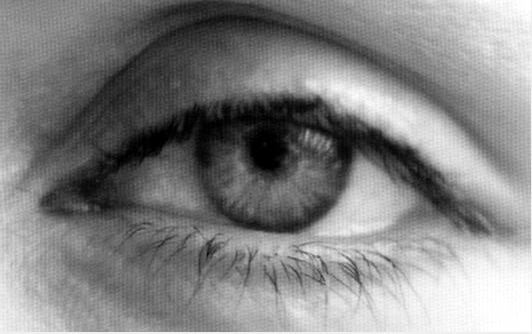
24 formula on the medium film / 24 sound quotes on film history / 25 frames of a blink of an eye.
Film is the word which fills the screen, white on green, silent. And then things begin to move, the writing rolls and the impressions crackle. More, however, towards the passages of the ear than in the direction of the retina, even when one sees an eye again and again. An eye - alone and larger than life - a dissected person and a film for the ears. Not only in the films of Gustav Deutsch and not only sometimes, cinema follows a convoluted logic.
24 terms associated with cinema - food for the ears and eyes - 24 two-second minimal films about audio-visual art. You read «memory» while an orchestra plays an emotionally loaded abbreviation representing all the flash-backs in the history of cinema. Read «propaganda» to a short war-like drum roll. «Language» appears and an unknown voice postulates, correctly, Godard. «Passion» is a short dialogue between screen lovers and «Light and Darkness» a salvo of percussive revolver shots.
Cinema is a battlefield and an amour fou, a time between two blinks of the eye or an artificially delineated territory between two signal beeps.
Perhaps this is an advertising film, but it is one which leaves its goal behind because in a few seconds, thousands of aspects of film watching, hearing and loving are packed in a nutshell - compressed «cinephilie».
(Stefan Grissemann)
“A film is a girl and a gun»: When Elisabeth Büttner saw the trailer of last year´s VIENNALE she remembered Godard´s words and wrote about them in a review. This gave me the idea of searching for similarly reduced and absolute theories, formulas and slogans about film. 24 of those slogans, accompanied by 24 2-second-long «quotes» from movie soundtracks, interrupted by 24 frames of eye movement, framed by the phrase FILM is more than FILM.”
(Gustav Deutsch)